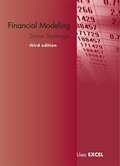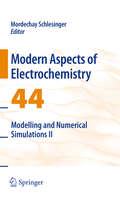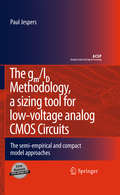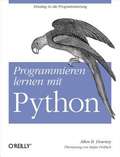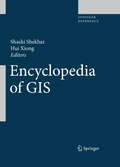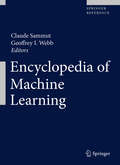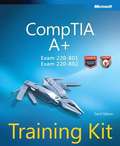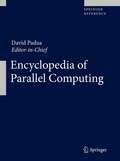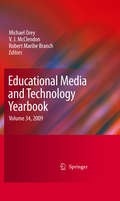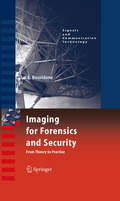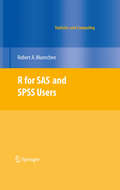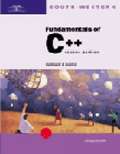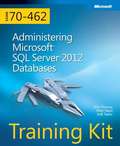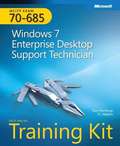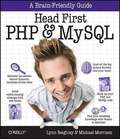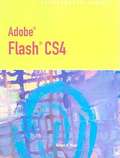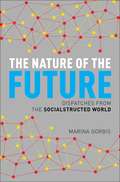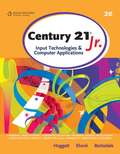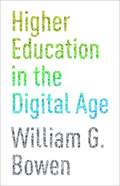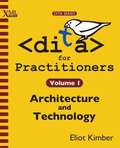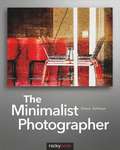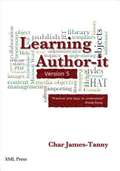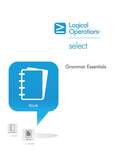- Table View
- List View
Financial Modeling (3rd Edition)
by Simon BenningaToo often, finance courses stop short of making a connection between textbook finance and the problems of real-world business. Financial Modeling bridges this gap between theory and practice by providing a nuts-and-bolts guide to solving common financial models with spreadsheets. Simon Benninga takes the reader step by step through each model, showing how it can be solved using Microsoft Excel. The long-awaited third edition of this standard text maintains the "cookbook" features and Excel dependence that have made the first and second editions so popular. It also offers significant new material, with new chapters covering such topics as bank valuation, the Black-Litterman approach to portfolio optimization, Monte Carlo methods and their applications to option pricing, and using array functions and formulas. Other chapters, including those on basic financial calculations, portfolio models, calculating the variance-covariance matrix,and generating random numbers, have been revised, with many offering substantially new and improved material. Other areas covered include financial statement modeling, leasing, standard portfolio problems, value at risk (VaR), real options, duration and immunization, and term structure modeling. Technical chapters treat such topics as data tables, matrices, the Gauss-Seidel method, and tips for using Excel. The last section of the text covers the Visual Basic for Applications (VBA) techniques needed for the book. The accompanying CD contains Excel worksheets and solutions to end-of-chapter exercises.
Modelling and Numerical Simulations II
by Mordechay SchlesingerThis volume is meant as an introductory resource aimed at practitioners of electrochemistry research, technology, and development mainly at the atomic, molecular or macromolecular levels. Thus emphasis is placed at length scales in the 1-100 nm range. The volume will help provide understanding of electrochemical phenomena and materials at the nanoscale through modeling and numeric simulations. It also serves as a means to create and use structures, electrochemically based devices, and systems that possess novel properties and functions because of their small or intermediate sizes.
The gm/ID Methodology, a sizing tool for low-voltage analog CMOS Circuits
by Paul JespersIC designers appraise currently MOS transistor geometries and currents to compromise objectives like gain-bandwidth, slew-rate, dynamic range, noise, non-linear distortion, etc. Making optimal choices is a difficult task. How to minimize for instance the power consumption of an operational amplifier without too much penalty regarding area while keeping the gain-bandwidth unaffected in the same time? Moderate inversion yields high gains, but the concomitant area increase adds parasitics that restrict bandwidth. Which methodology to use in order to come across the best compromise(s)? Is synthesis a mixture of design experience combined with cut and tries or is it a constrained multivariate optimization problem, or a mixture? Optimization algorithms are attractive from a system perspective of course, but what about low-voltage low-power circuits, requiring a more physical approach? The connections amid transistor physics and circuits are intricate and their interactions not always easy to describe in terms of existing software packages. The gm/ID synthesis methodology is adapted to CMOS analog circuits for the transconductance over drain current ratio combines most of the ingredients needed in order to determine transistors sizes and DC currents.
Programmieren lernen mit Python
by Allen B. DowneyPython ist eine moderne, interpretierte, interaktive und objektorientierte Skriptsprache, vielseitig einsetzbar und sehr beliebt. Mit mathematischen Vorkenntnissen ist Python leicht erlernbar und daher die ideale Sprache für den Einstieg in die Welt des Programmierens. Das Buch führt Sie Schritt für Schritt durch die Sprache, beginnend mit grundlegenden Programmierkonzepten, über Funktionen, Syntax und Semantik, Rekursion und Datenstrukturen bis hin zum objektorientierten Design. Jenseits reiner Theorie: Jedes Kapitel enthält passende Übungen und Fallstudien, kurze Verständnistests und kleinere Projekte, an denen Sie die neu erlernten Programmierkonzepte gleich ausprobieren und festigen können. Auf diese Weise können Sie das Gelernte direkt anwenden und die jeweiligen Programmierkonzepte nachvollziehen. Lernen Sie Debugging-Techniken kennen: Am Ende jedes Kapitels finden Sie einen Abschnitt zum Thema Debugging, der Techniken zum Aufspüren und Vermeiden von Bugs sowie Warnungen vor entsprechenden Stolpersteinen in Python enthält. Starten Sie durch: Beginnen Sie mit den Grundlagen der Programmierung und den verschiedenen Programmierkonzepten, und lernen Sie, wie ein Informatiker zu programmieren.
Encyclopedia of GIS
by Shashi Shekhar Hui XiongThe Encyclopedia of GIS provides a comprehensive and authoritative guide, contributed by experts and peer-reviewed for accuracy, and alphabetically arranged for convenient access. The entries explain key software and processes used by geographers and computational scientists. Major overviews are provided for nearly 200 topics: Geoinformatics, Spatial Cognition, and Location-Based Services and more. Shorter entries define specific terms and concepts. The reference will be published as a print volume with abundant black and white art, and simultaneously as an XML online reference with hyperlinked citations, cross-references, four-color art, links to web-based maps, and other interactive features.
Encyclopedia of Machine Learning
by Claude Sammut Geoffrey I. WebbThis comprehensive encyclopedia, in A-Z format, provides easy access to relevant information for those seeking entry into any aspect within the broad field of Machine Learning. Most of the entries in this preeminent work include useful literature references.
CompTIA A+ (Exam 220-801 and Exam 220-802) Training Kit
by Darril GibsonCompTIA A+ Exams 220-801 and 220-802 candidates can ace their preparation with this training kit that allows them to work at their own pace through a series of lessons and practical exercises, and then assess their computing technology skills with the online practice test--featuring multiple, customizable testing options to meet their specific needs.
Encyclopedia of Parallel Computing
by David PaduaContaining over 300 entries in an A-Z format, the Encyclopedia of Parallel Computing provides easy, intuitive access to relevant information for professionals and researchers seeking access to any aspect within the broad field of parallel computing. Topics for this comprehensive reference were selected, written, and peer-reviewed by an international pool of distinguished researchers in the field. The Encyclopedia is broad in scope, covering machine organization, programming languages, algorithms, and applications. Within each area, concepts, designs, and specific implementations are presented. The highly-structured essays in this work comprise synonyms, a definition and discussion of the topic, bibliographies, and links to related literature. Extensive cross-references to other entries within the Encyclopedia support efficient, user-friendly searchers for immediate access to useful information. Key concepts presented in the Encyclopedia of Parallel Computing include; laws and metrics; specific numerical and non-numerical algorithms; asynchronous algorithms; libraries of subroutines; benchmark suites; applications; sequential consistency and cache coherency; machine classes such as clusters, shared-memory multiprocessors, special-purpose machines and dataflow machines; specific machines such as Cray supercomputers, IBM's cell processor and Intel's multicore machines; race detection and auto parallelization; parallel programming languages, synchronization primitives, collective operations, message passing libraries, checkpointing, and operating systems. Topics covered: Speedup, Efficiency, Isoefficiency, Redundancy, Amdahls law, Computer Architecture Concepts, Parallel Machine Designs, Benmarks, Parallel Programming concepts & design, Algorithms, Parallel applications. This authoritative reference will be published in two formats: print and online. The online edition features hyperlinks to cross-references and to additional significant research. Related Subjects: supercomputing, high-performance computing, distributed computing
Educational Media and Technology Yearbook, Volume 34
by Robert Maribe Branch V. J. Mcclendon Michael OreyThe Educational Media and Technology Yearbook is dedicated to theoretical, empirical and practical approaches to educational media development. All chapters are invited and selected based on a variety of strategies to determine current trends and issues in the field. The 2009 edition will highlight innovative Trends and Issues in Learning Design and Technology, Trends and Issues in Information and Library Science, and features a section that lists and describes Media Related Organizations and Associations in North America. <P><P> The Educational Media and Technology Yearbook, a scholarly resource for a highly specialized professional community, is an official publication of the AECT and has been published annually for 33 years.
Imaging for Forensics and Security
by Ahmed BouridaneImaging for Forensics and Security: From Theory to Practice provides a detailed analysis of new imaging and pattern recognition techniques for the understanding and deployment of biometrics and forensic techniques as practical solutions to increase security. It contains a collection of the recent advances in the technology ranging from theory, design, and implementation to performance evaluation of biometric and forensic systems. This book also contains new methods such as the multiscale approach, directional filter bank, and wavelet maxima for the development of practical solutions to biometric problems. The book introduces a new forensic system based on shoeprint imagery with advanced techniques for use in forensics applications. It also presents the concept of protecting the originality of biometric images stored in databases against intentional and unintentional attacks and fraud detection data in order to further increase the security.
R for SAS and SPSS Users
by Robert A. MuenchenThis book introduces R using SAS and SPSS terms. It demonstrates which of the add-on packages are most like SAS and SPSS and compares them to R's built-in functions. It compares and contrasts the differing approaches of all three packages.
iPolitics: Citizens, Elections, and Governing in the New Media Era
by Richard L. Fox Jennifer M. RamosPoliticians rely on Twitter, Facebook and YouTube to exercise political power. Citizens around the world also use these tools to vent political frustrations, join political groups and organize revolutions. Political activists blog to promote candidates, solicit and coordinate financial contributions and provide opportunities for volunteers. iPolitics describes the ways in which new media innovations change how politicians and citizens engage the political arena. Among other things, contributors to this volume analyze whether the public's political knowledge has increased or decreased in the new media era, the role television still plays in the information universe, the effect bloggers have had on the debate and outcome of healthcare reform, and the manner in which political leaders should navigate the new media environment. While the majority of contributors examine new media and politics in the United States, the volume also provides a unique comparative perspective on this relationship using cases from abroad.
Fundamentals of C++: Introductory Course (2nd Edition)
by Kenneth Lambert Douglas W. NanceFollowing the success of Fundamentals of C++ by Lambert and Nance, C++ Introductory course is essential for a first course in Computer Science. Completely updated, this text provides in-depth coverage to help students prepare for the AP exam, Exam A. A full introduction to the essential features of C++ is provided and programming techniques are emphasized in the context of interesting and realistic case problems. This text is compatible with C++ compilers from Microsoft, Borland, and Metrowerks.
Training Kit (Exam 70-462): Administering Microsoft SQL Server 2012 Databases
by Orin Thomas Peter Ward Bob TaylorThis training kit is designed for information technology (IT) professionals who support or plan to support Microsoft SQL Server 2012 databases and who also plan to take Exam 70-462, "Administering Microsoft SQL Server 2012 Databases."
MCITP Self-Paced Training Kit (Exam 70-685): Windows 7 Enterprise Desktop Support Technician
by Tony Northrup J. C. MackinThis training kit is designed for IT support personnel who support Windows 7 at the Tier 1 or Tier 2 level in a wide range of environments and who plan to take the Microsoft Certified Information Technology Professional (MCITP) exam 70-685.
Head First PHP and MySQL
by Michael Morrison Lynn BeighleyIf you're ready to create web pages more complex than those you can build with HTML and CSS, Head First PHP & MySQL is the ultimate learning guide to building dynamic, database-driven websites using PHP and MySQL. Packed with real-world examples, this book teaches you all the essentials of server-side programming, from the fundamentals of PHP and MySQL coding to advanced topics such as form validation, session IDs, cookies, database queries and joins, file I/O operations, content management, and more. Head First PHP & MySQL offers the same visually rich format that's turned every title in the Head First series into a bestseller, with plenty of exercises, quizzes, puzzles, and other interactive features to help you retain what you've learned. Use PHP to transform static HTML pages into dynamic web sites Create and populate your own MySQL database tables, and work with data stored in files Perform sophisticated MySQL queries with joins, and refine your results with LIMIT and ORDER BY Use cookies and sessions to track visitors' login information and personalize the site for users Protect your data from SQL injection attacks Use regular expressions to validate information on forms Dynamically display text based on session info and create images on the fly Pull syndicated data from other sites using PHP and XML Throughout the book, you'll build sophisticated examples -- including a mailing list, a job board, and an online dating site -- to help you learn how to harness the power of PHP and MySQL in a variety of contexts. If you're ready to build a truly dynamic website, Head First PHP & MySQL is the ideal way to get going.
Adobe Flash CS4 Illustrated
by Barbara M. WaxerADOBE FLASH CS4 ILLUSTRATED utilizes a reader-friendly format, offering instructions and succinct lessons to help readers grasp Adobe Flash CS4.
The Nature of the Future
by Marina GorbisA renowned futurist offers a vision of a reinvented world. Large corporations, big governments, and other centralized organizations have long determined and dominated the way we work, access healthcare, get an education, feed ourselves, and generally go about our lives. The economist Ronald Coase, in his famous 1937 paper "The Nature of the Firm," provided an economic explanation for this: Organizations lowered transaction costs, making the provision of goods and services cheap, efficient, and reliable. Today, this organizational advantage is rapidly disappearing. The Internet is lowering transaction costs--costs of connection, coordination, and trade--and pointing to a future that increasingly favors distributed sources and social solutions to some of our most immediate needs and our most intractable problems. As Silicon Valley thought-leader Marina Gorbis, head of the Institute for the Future, portrays, a thriving new relationship-driven or socialstructed economy is emerging in which individuals are harnessing the powers of new technologies to join together and provide an array of products and services. Examples of this changing economy range from BioCurious, a members-run and free-to-use bio lab, to the peer-to-peer lending platform Lending Club, to the remarkable Khan Academy, a free online-teaching service. These engaged and innovative pioneers are filling gaps and doing the seemingly impossible by reinventing business, education, medicine, banking, government, and even scientific research. Based on extensive research into current trends, she travels to a socialstructed future and depicts an exciting vision of tomorrow.
Century 21® Jr., Input Technologies & Computer Applications
by Jack P. Hoggatt Jon A. Shank Karl BarksdaleLooking for a solution to get your students started in the computer world? This introductory text, CENTURY 21, JR. INPUT TECHNOLOGIES AND COMPUTER APPLICATIONS, 2e is the perfect companion for navigation of computer basics, file management, the Internet, keyboarding, handwriting recognition, speech recognition, tablet PCs, word processing, desktop publishing, spreadsheets, presentations, databases, HTML programming, and Web pages. CENTURY 21, JR. provides step-by-step guidance, with engaging activities labeled as Learn, Practice, and Apply. Units are divided into easy-to-manage chapters and projects will help students learn the features of Microsoft Office 2007.
Higher Education in the Digital Age
by William G. BowenTwo of the most visible and important trends in higher education today are its exploding costs and the rapid expansion of online learning. Could the growth in online courses slow the rising cost of college and help solve the crisis of affordability? In this short and incisive book, William G. Bowen, one of the foremost experts on the intersection of education and economics, explains why, despite his earlier skepticism, he now believes technology has the potential to help rein in costs without negatively affecting student learning. As a former president of Princeton University, an economist, and author of many books on education, including the acclaimed bestseller The Shape of the River, Bowen speaks with unique expertise on the subject.Surveying the dizzying array of new technology-based teaching and learning initiatives, including the highly publicized emergence of "massive open online courses" (MOOCs), Bowen argues that such technologies could transform traditional higher education--allowing it at last to curb rising costs by increasing productivity, while preserving quality and protecting core values. But the challenges, which are organizational and philosophical as much as technological, are daunting. They include providing hard evidence of whether online education is cost-effective in various settings, rethinking the governance and decision-making structures of higher education, and developing customizable technological platforms. Yet, Bowen remains optimistic that the potential payoff is great.Based on the 2012 Tanner Lectures on Human Values, delivered at Stanford University, the book includes responses from Stanford president John Hennessy, Harvard University psychologist Howard Gardner, Columbia University literature professor Andrew Delbanco, and Coursera cofounder Daphne Koller.
DITA for Practitioners Volume 1
by Eliot KimberDITA expert Eliot Kimber takes you inside the DITA XML standard, explaining the architecture and technology that make DITA unique. Volume 1 of his two-volume exploration of DITA starts with a hands-on explanation of end-to-end DITA processing that will get you up and running fast. Then, he explores the DITA architecture, explaining maps and topics, structural patterns, metadata, linking and addressing, keys and key references, relationship tables, conditional processing, reuse, and more. DITA for Practitioners Volume 1: Architecture and Technology is for engineers, tool builders, and content strategists: anyone who designs, implements, or supports DITA-based systems and needs a deeper understanding of DITA technology. Kimber's unique perspective unwraps the puzzle that is DITA, explaining the rationale for its design and structure, and giving you an unvarnished, detailed look inside this important technology.
The Minimalist Photographer
by Steve JohnsonThis book covers photography from a minimalist perspective, proving that it is possible to take very good photographs with relatively cheap equipment. The minimalist process emphasizes the importance of first knowing what you want to achieve as a photographer and then choosing the most effective equipment, subject matter, and general approach to meet your goals. The minimalist photographer works with the idea that the brain and the eye are far more important than the camera. Author Steve Johnson begins by asking you, the reader, to look inward and make the connections between your nature and your photography. Why do you want to take photographs and what subject matter are you attracted to? What type of photographer are you now and what type of photographer would you like to become? These are important questions to consider when deciding what approach works best for you. In subsequent chapters, you'll learn about the equipment and workflow of a minimalist photographer as Johnson discusses the strengths and weaknesses of various types of cameras and explains why the biggest or most expensive piece of equipment is not always the best. He also addresses the importance of lighting and teaches you how to achieve effective lighting without spending a lot of money. Also included are discussions about aesthetics and composition, as well as a brief history of photography and the future of the art form.
Learning Author-it
by Char James-TannyLet Author-it guru Char James-Tanny teach you how to get the most from Author-it. Char has taught hundreds in her acclaimed classes, and now she has drawn from her extensive experience to create the definitive resource for learning Author-it. Whether you are new to Author-it or an experienced user, there is something here for you. If you are just starting out with Author-it, Learning Author-it will make the sometimes daunting learning curve for Author-it smoother and easier. You will learn how libraries work, how to wrap your head around Author-it's object-oriented structure, how to work with your content, and how to publish your output. If you are an experienced Author-it user, get a refresher from someone who uses Author-it like a technical writer. Char provides dozens of tips, helpful screenshots, and more than 150 tasks to help increase your efficiency (and lessen any frustration). And you'll find lots of tips and tricks that will improve your productivity.Inside the Book Understanding and setting up your library Understanding the authoring environment Creating content Reusing topic content Viewing, finding, and organizing topics Publishing the output Customizing objects for different outputs Maintaining the library Index
Grammar Essentials
by Susan HermanImproving your grammar will help you deliver polished and professional written communications. Correct grammar and a refined, concise writing style can help you clearly articulate your ideas to others, streamline the directions and instructions that you deliver, and create impressive presentations and reports.
